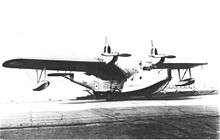Rolls-Royce Goshawk
| Goshawk | |
|---|---|
| | |
| Type | Piston V-12 aero engine |
| Manufacturer | Rolls-Royce Limited |
| First run | 1933 |
| Major applications | see #Applications |
| Number built | 20 |
| Developed from | Rolls-Royce Kestrel |
The Rolls-Royce Goshawk was a development of the Rolls-Royce Kestrel that used evaporative or steam cooling. In line with Rolls-Royce convention of naming piston engines after birds of prey, it was named after the goshawk.
The engine first ran in 1933 and provided 660 horsepower (490 kW). Only a few engines were built as the aircraft designs intended to use it were not adopted by the Royal Air Force. The Goshawk was used to power the Short Knuckleduster, the Supermarine Type 224 (a predecessor to the Supermarine Spitfire) and other prototype aircraft.
Design and development
The Goshawk was developed from the Kestrel IV prototype engine, to use evaporative (also known as "steam") cooling. Rather than keep the cooling liquid below its boiling point in the cooling system, the coolant was allowed to boil; the phase change from liquid to vapour takes more heat from the engine, so less coolant is needed. However, instead of a radiator to take the heat from the coolant, a condensor was required to turn the vapour back to liquid. This had to be much larger than a radiator and added drag to the aircraft design.
Twenty engines were built and they flew only in prototypes as a few manufacturer's private ventures and "one offs". Powers for individual installations are quoted between 650 and 700 hp (520 kW). Problems with coolant leaks, coolant pumping and the realisation that large wing mounted radiators would be vulnerable to combat damage caused the project to be cancelled although valuable lessons had been learned and were put to good use with development of the later Merlin.[1]
Variants
- Goshawk I
- (1932) Developed from the prototype Kestrel IV.
- Goshawk II
- (1935) 600 hp. Lowered propeller reduction gear ratio.
- Goshawk III
- (1935) 600hp. Further reduction of gear ratio.
- Goshawk VI
- 660 hp. High ratio reduction gear.
- Goshawk VII
- 660 hp. Raised reduction gear ratio.
- Goshawk VIII
- 660 hp. Special experimental engine. Maximum power output: 837 hp.
Applications

The Goshawk was the power unit specified for the twin engined Short Knuckleduster flying boat (K3574) to Specification R24/31 and "preferred" for submissions to Air Ministry specification F7/30 for a fighter aircraft. Goshawks were used by all three officially sponsored prototypes, the Supermarine Type 224 (K2890),the Westland F.7/30 (K2891) and the Blackburn F3 (K2892), which only taxied with the Goshawk fitted and did not fly, in addition to two private venture entrants, the Bristol Type 123 and the Hawker P.V.3.
The Goshawk also powered Hawker's privately developed "High Speed Fury Mk 2" (K3586) and "Intermediate Fury" 2" (the latter Hawker's own development aircraft and "hack" serial G-ABSE)[2] and the Westland Pterodactyl V (K2770) and was installed for trials in the Gloster TSR.38 (S1705), and the first Gloster Gnatsnapper prototype (N227).
Application list
- Blackburn F3
- Bristol Type 123
- Gloster Gnatsnapper
- Hawker Fury
- Hawker P.V.3
- Supermarine Type 224
- Westland Pterodactyl V
- Westland F.7/30 (sometimes called the Westland P.V.4)
Specifications (Goshawk I)
Data from Lumsden[3]
General characteristics
- Type: 12-cylinder liquid-cooled 60 degree Vee aircraft piston engine
- Bore: 5.0 in (127 mm)
- Stroke: 5.5 in (140 mm)
- Displacement: 1,295.88 in3 (21.25 L)
- Length: 74.61 in (1,895 mm)
- Width: 24.41 in (620 mm)
- Height: 35.63 in (905 mm)
- Dry weight: 975 lb (442 kg)
Components
- Valvetrain: OHC - Overhead Camshaft
- Supercharger: Single-stage supercharger
- Fuel type: 77 Octane petrol
- Cooling system: Liquid-cooled
Performance
- Power output: 600 bhp (447 kW) at 2,600 rpm
- Specific power: 0.46 hp/in3 (21 kW/L)
- Compression ratio: 6:1
- Power-to-weight ratio: 0.61 hp/lb (1 kW/kg)
See also
- Related development
- Comparable engines
- Related lists
References
- Notes
- ↑ Gunston 1989, p.141.
- ↑ "Fighting Breed" Flight 1951 p692
- ↑ Lumsden 2003, p.197.
- Bibliography
- Gunston, Bill. World Encyclopedia of Aero Engines. Cambridge, England. Patrick Stephens Limited, 1989. ISBN 1-85260-163-9
- Lumsden, Alec. British Piston Engines and their Aircraft. Marlborough, Wiltshire: Airlife Publishing, 2003. ISBN 1-85310-294-6.
- "The Two Rs" Flight 1954 from archive at Flightglobal.com
Further reading
- Rubbra, A.A. Rolls-Royce Piston Aero Engines - a designer remembers: Historical Series no 16 :Rolls Royce Heritage Trust, 1990. ISBN 1-872922-00-7